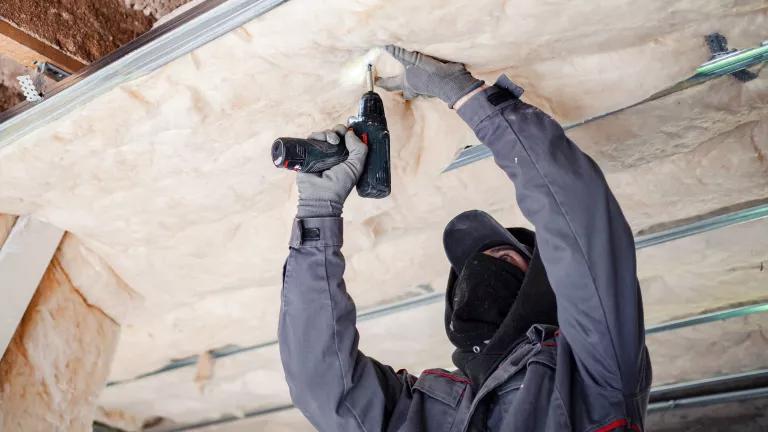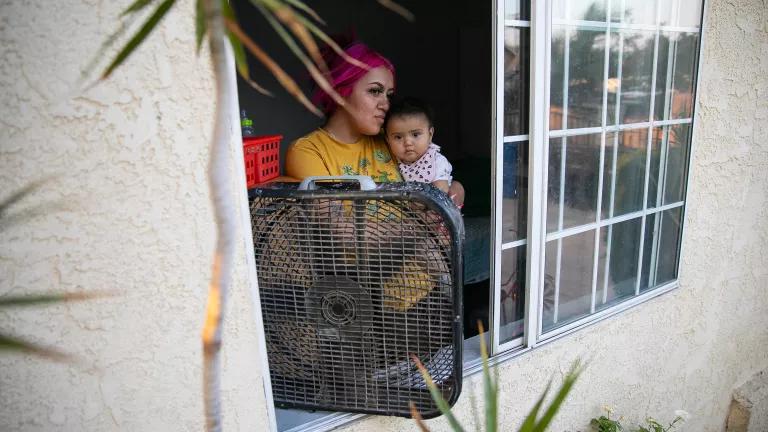Bill Relief, Efficiency, and Decarb Reduce Gas Price Shocks
The California Public Utilities Commission can and must act now to protect low-income customers.

A construction worker installing mineral wool insulation in a home
Viktor Cvetkovic/Getty Images
Residential gas customers in California are facing exorbitantly high bills due to market conditions, such as high demand for heating caused by exceptional low temperatures. This sudden spike in gas prices will especially come as a shock to lower-income customers who may see their bills increase two-fold in the matter of a month. The good news is that the California Public Utilities Commission (CPUC) can and must act now to protect them.
The CPUC should institute bill surge protection measures to provide immediate relief for low-income customers. The CPUC should also develop strategies to avoid this situation in the future, such as reinforcing energy efficiency programs to weatherize homes, providing customers with accurate information about gas prices, as well as initiating long-term gas transition planning with a focus on making building electrification accessible for low-income families.
A Supply-Demand Mismatch Is Causing Wholesale Gas Prices to Spike
The CPUC has jurisdiction over natural gas rates and services, but it does not regulate the price of the natural gas commodity in the wholesale market. Rather, natural gas commodity prices go up and down in response to market forces. Wholesale market prices are largely passed on to customers, but they usually do not see real-time price changes. The price a utility pays today in the wholesale market will only appear to customers in their next month’s bill.
Market conditions affected by an unprecedented cold winter are spiking wholesale prices and causing extraordinary impacts on natural gas rates in California. In December 2022, the frigid air penetrating the West Coast resulted in an increase in demand for heating and the region saw massive gas price increases. Things got worse in January 2023 and natural gas wholesale prices increased even more. For instance, January 2023 prices in SoCalGas territory are more than 310% higher than January 2022 (see this graph by the LA Times). While natural gas market prices may be lower elsewhere in the country, they remain elevated in the Pacific region where gas demand is high due to cold weather and low storage levels. This blog by Berkeley professor Severin Borenstein explains in more detail some of the reasons for gas price spikes on the West Coast.
This scenario is problematic and high bills may come as a shock in the next month, especially to customers facing economic hardship. Therefore, we need to address two main questions: (1) How do we protect low-income customers against the current situation and (2) How do we make sure this does not happen again?
A Two-Part Solution: Near-Term Bill Relief and Policy Updates for the Long-Term
The Public Advocates Office urged the CPUC to take two immediate actions to allow for interim relief to natural gas customers. First, the CPUC should require natural gas utilities to distribute the natural gas Climate Credits in February 2023, applying them to January 2023 bills. In addition, the CPUC should adopt automatic enrollment in payment plans for all customers to provide near-term relief, similar to the adoption of long-term payment plans for COVID-19 arrearage relief.
NRDC supports PAO’s motion because those two actions will help protect low-income customers from the significant increases in natural gas market prices. But more is needed to help avoid this situation in the future. NRDC asked the CPUC to:
- Require gas utilities to alert customers when gas prices are expected to rise more than 50% (or another benchmark figure) month over month. Without the necessary information and tools to decrease demand, supply shortages will only get worse, and prices will keep rising.
- Develop ready-to-implement utility debt relief steps for CARE customers, similar to PAO’s proposal, if gas prices are expected to increase over 50%.
- Continue to support low-income efficiency programs, such as the Energy Savings Assistance Program, to weatherize homes. Weatherization will reduce demand for heating and cooling and will help curb demand during extreme weather events.
- Initiate long-term gas transition planning with a focus on supporting electrification for CARE customers to ensure that they are not left paying for the gas infrastructure as wealthier Californians electrify.
The situation is challenging and requires immediate action. The CPUC can and must apply its authority to manage gas bills and protect low-income customers.



